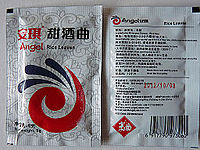
Photo from wikipedia
Peas are prospectively beneficial legumes in the human diet, and especially in a vegan and vegetarian diet, due to their high content of proteins and starch. Their frequent lack of… Click to show full abstract
Peas are prospectively beneficial legumes in the human diet, and especially in a vegan and vegetarian diet, due to their high content of proteins and starch. Their frequent lack of appeal in human nutrition can be caused by their bloating effect and the content of some antinutritional compounds inhibiting the absorption of important nutrients. This study brings a comprehensive comparison of the nutrient content of pea flour after cooking and lactic fermentation before and after digestion in vitro. As a control sample, raw pea flour was used (sample 1). Raw pea flour was cooked for 10 min (sample 2) and 120 min (sample 3) at 100°C or it was fermented by Lactobacillus plantarum (sample 4) and cooked for 10 min at 100°C (sample 5). The samples were analyzed for protein and amino acids content, maltose, glucose, raffinose, total polyphenols, phytic acid, phytase, and mineral composition (P, Mg, Mn, Fe, Cu, Zn) before and after in vitro digestion. The results showed a significant (p < 0.05) increase in the protein digestibility of samples 3, 4 and 5. In the fermented samples were observed a higher concentration of Cys, Met, and Gln when compared to non-fermented samples. The fermentation of pea flour resulted in a significant (p < 0.05) decrease in glucose, maltose, and raffinose content. Cooking of pea flour for 10 and 120 min, but not fermenting, significantly (p < 0.05) decreased the polyphenols content. Cooking and fermentation together did not affect phytic acid concentration and phytase activity. Mg, Mn, Fe, Cu and, Zn concentration in pea flour was significantly (p < 0.05) decreased by cooking. On the other hand, fermentation significantly (p<0.05) improved the bioaccessibility of Mn and Fe. These findings suggest that lactic fermentation of pea flour is a promising culinary preparation that can improve the digestibility of peas.
Journal Title: Frontiers in Nutrition
Year Published: 2022
Link to full text (if available)
Share on Social Media: Sign Up to like & get
recommendations!